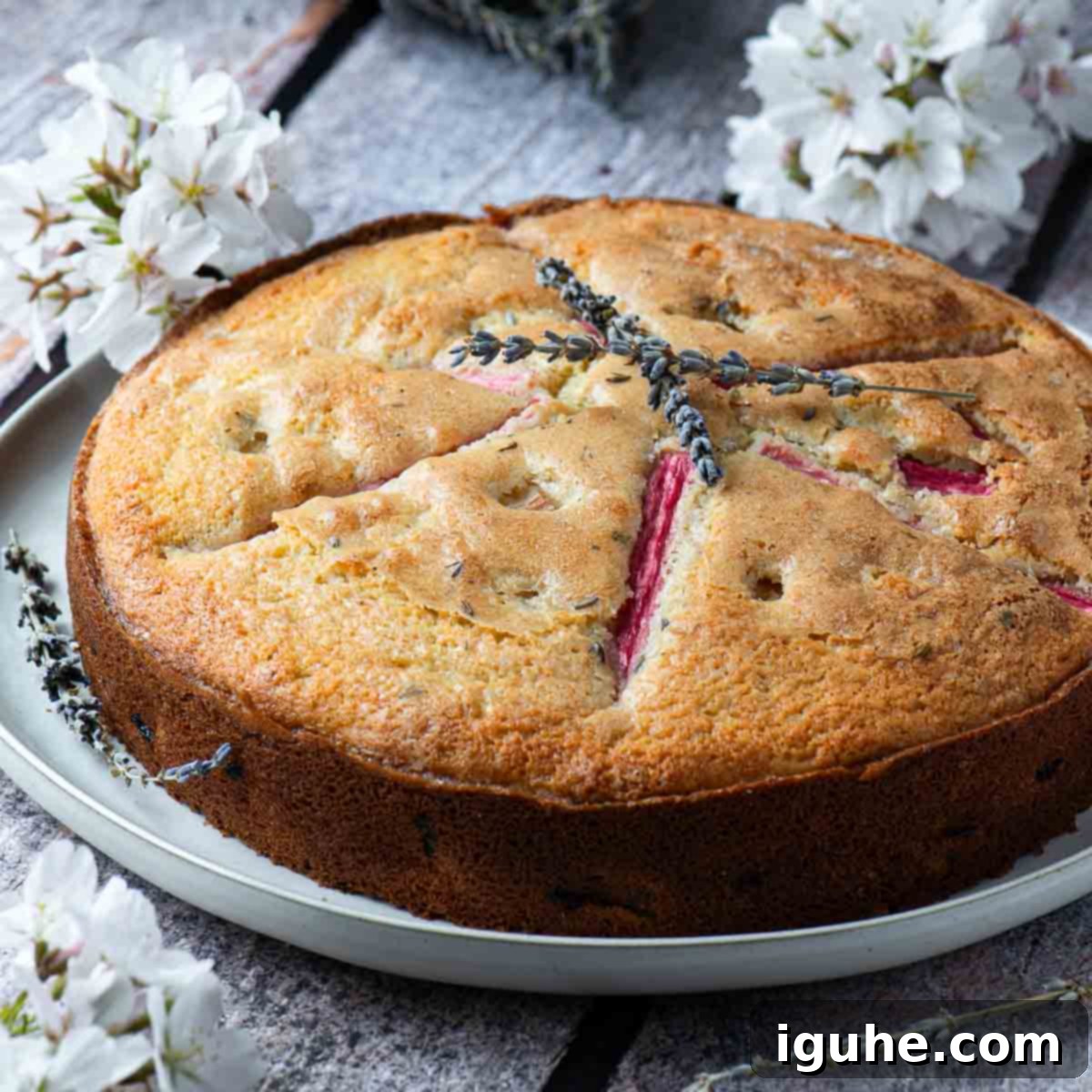Rhubarb and Lavender Cake: Your Ultimate Guide to a Fragrant Spring Dessert
Prepare to delight your senses with a slice of this exquisite Rhubarb and Lavender Cake. This recipe offers a sophisticated and utterly delightful twist on traditional spring desserts, masterfully blending the tartness of fresh rhubarb with the subtle, aromatic notes of culinary lavender. A hint of bright lemon zest completes this harmonious flavor profile, making it a truly unforgettable bake.
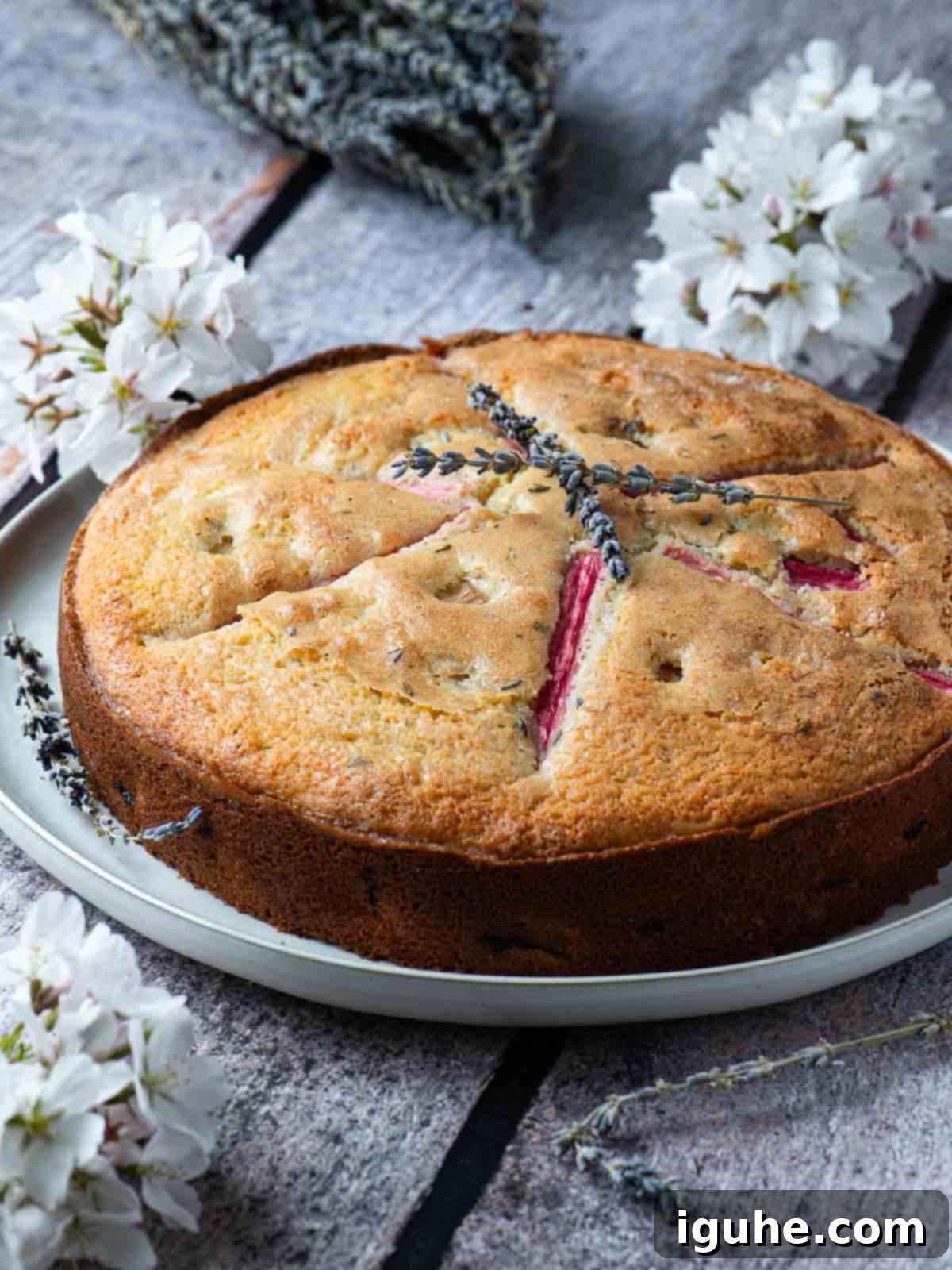
While rhubarb and strawberries often form a classic pairing, this recipe invites you to explore a new dimension of flavor. We’ve introduced the delicate, floral essence of lavender, allowing its subtle fragrance to beautifully complement the tangy rhubarb. This combination creates a dessert that is both unexpected and deeply satisfying, moving beyond the familiar to offer something truly special.
Perfect for celebrating the arrival of spring and summer, this rustic, one-layer cake is surprisingly simple to prepare, yet it yields an elegant result. The unique trio of rhubarb, lavender, and lemon culminates in a dessert that strikes a perfect balance between comforting and refined. It’s an ideal choice for a celebratory brunch, a charming afternoon tea, or as a light and fragrant conclusion to any meal. Its unique character ensures it will be a conversation starter and a beloved addition to your seasonal baking repertoire.
Essential Ingredients for Your Rhubarb Lavender Cake
Rhubarb graces us with its presence from late March through early summer, so seize the opportunity to bake with it as soon as it appears. Understanding each ingredient’s role will ensure your cake turns out perfectly. Below is a comprehensive look at what you’ll need, along with tips for selection and preparation.
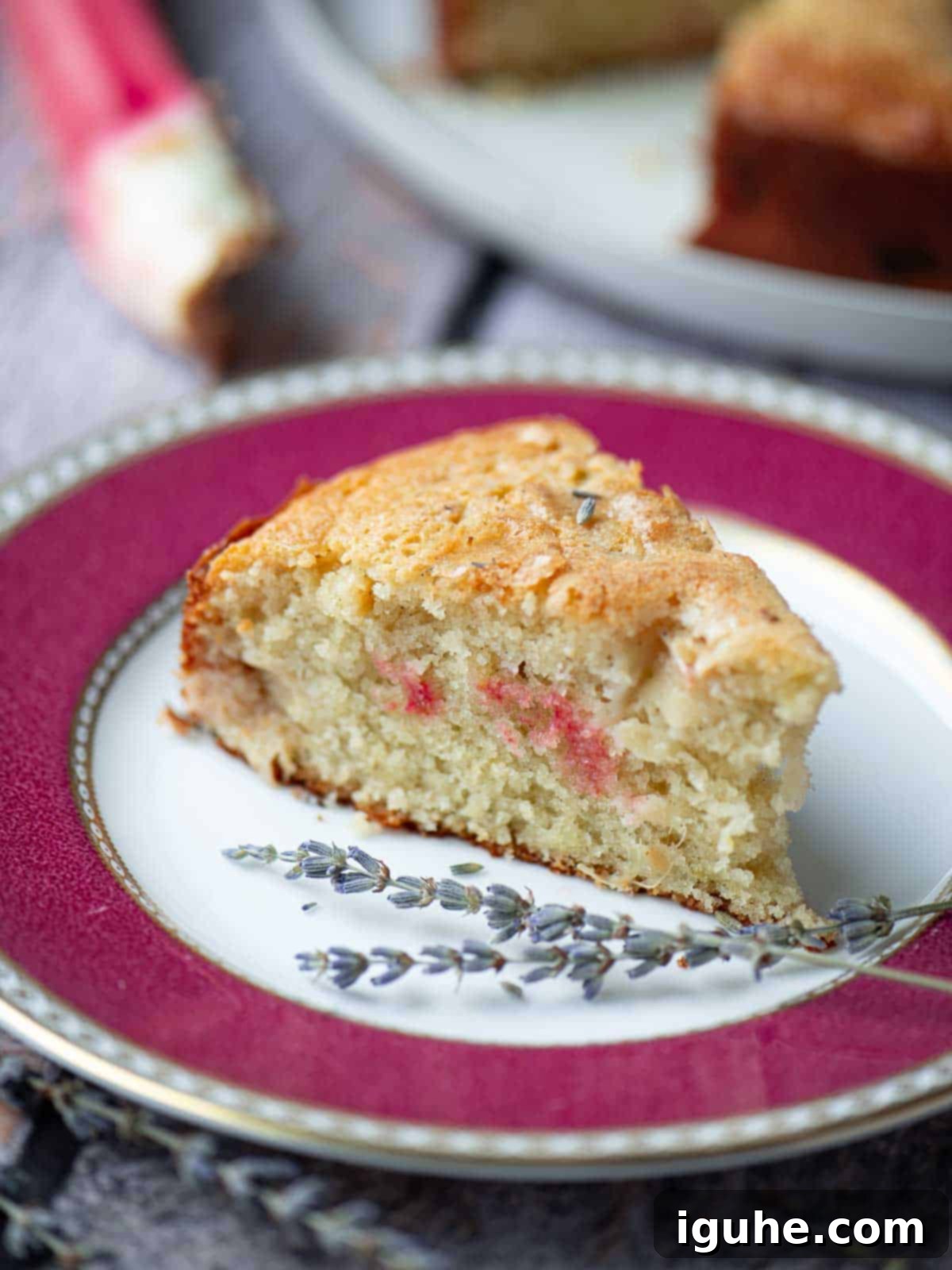
- Flour: This recipe utilizes a balanced blend of all-purpose flour for structure and almond flour for a tender, moist crumb. The almond flour not only enhances the texture but also adds a subtle nutty flavor, contributing to the cake’s luxurious feel and helping it stay fresh longer.
- Baking Powder and Baking Soda: These essential leavening agents work together to give the cake its beautiful rise and airy texture. They react with the acidic buttermilk to create carbon dioxide, resulting in a light and fluffy crumb.
- Salt: A small but crucial addition, salt enhances all the other flavors in the cake, balancing the sweetness and brightening the unique notes of rhubarb and lavender. Always use Kosher or fine sea salt for best results.
- Ground Ginger: This subtle spice acts as a wonderful enhancer, bringing out the bright citrus notes of the lemon and the tang of the rhubarb. It adds a gentle warmth without making the cake overtly spicy, creating a more complex flavor profile.
- Culinary Lavender Buds: The star floral element! It’s imperative to purchase culinary or food-grade lavender. This type of lavender has a lower camphor content, which prevents any bitter or medicinal taste. Culinary lavender offers a sweet, gentle, and highly fragrant note that pairs exceptionally well with tart fruits. Beyond this cake, it’s incredibly versatile for infusions, syrups, and even cocktails. You can often find lavender buds in the spice section of gourmet grocery and specialty stores, or purchase them conveniently online.
- Buttermilk: Renowned for contributing incredible moisture and a tender crumb to baked goods, buttermilk’s acidity also reacts with baking soda to create a lighter cake. If you don’t have buttermilk, a quick homemade substitute can be made by adding one tablespoon of lemon juice or white vinegar to a measuring cup and then filling it to the one-cup mark with milk. Let it sit for 5-10 minutes until it slightly curdles. Greek yogurt or sour cream can also be used as alternatives, ensuring they are at room temperature.
- Unsalted Butter: Using unsalted butter gives you precise control over the total salt content in your recipe. It’s essential that the butter is at room temperature for proper creaming, a vital step for incorporating air and creating a light, fluffy cake structure.
- Vanilla Extract: Pure vanilla extract provides a comforting and classic sweetness that beautifully harmonizes with both the tart rhubarb and the delicate floral notes of lavender, ensuring a well-rounded flavor profile.
- Fresh Lemon Zest: Grated directly into the batter, fresh lemon zest offers a bright, citrusy lift that enhances the tanginess of the rhubarb and complements the subtle floral notes of lavender. Always zest the lemon before juicing it.
- Fresh Rhubarb: Look for firm, crisp stalks that are vibrant in color. Depending on the variety, rhubarb can range from bright red to pink or even pale green. Avoid limp or bruised stalks. Rhubarb leaves are toxic, so they are typically removed before selling. This seasonal ingredient is best enjoyed during its peak availability in spring and early summer.
The full ingredient list with precise measurements can be found in the recipe card below.
Crafting Your Rhubarb Lavender Cake: A Detailed Guide
Follow these detailed steps to create this unique and fragrant lavender cake, ensuring a perfect bake every time.
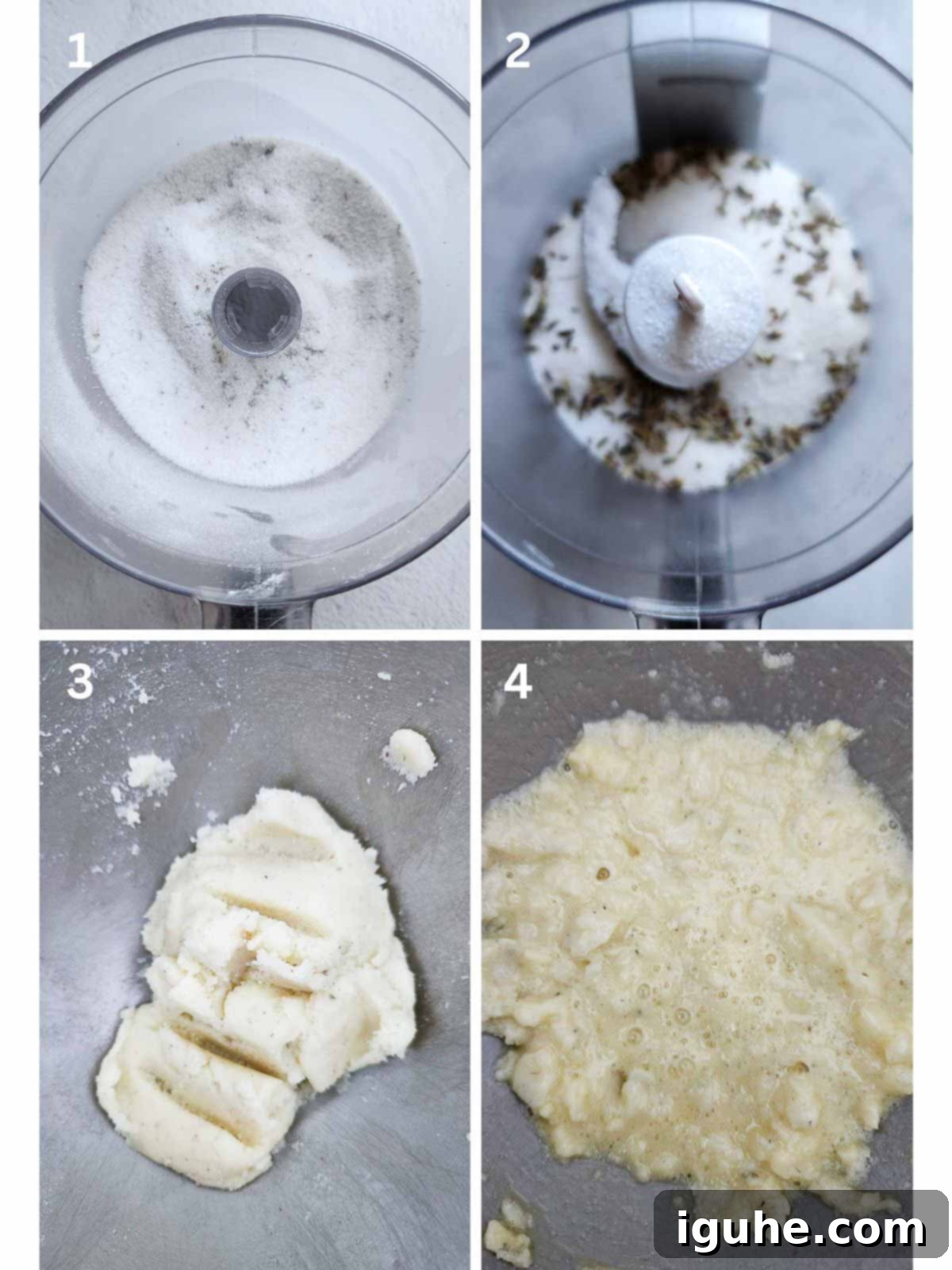
1-2. Make the Lavender Sugar: Begin by combining the white granulated sugar and culinary lavender buds in a food processor, spice grinder, or using a mortar and pestle. Pulse until the lavender is finely broken down and the sugar is infused with its beautiful aroma. This step ensures the floral notes are evenly distributed throughout the cake.
3. Cream Butter and Sugar: In the bowl of a stand mixer fitted with the paddle attachment (or using a handheld mixer), cream together the softened unsalted butter with the granulated sugar and most of the lavender sugar (reserve 1 tablespoon for sprinkling later). Beat on medium speed for about 3 minutes until the mixture is light, fluffy, and pale, incorporating plenty of air.
4. Add Eggs: With the mixer still running on medium speed, add the room-temperature eggs one at a time, mixing well after each addition until fully incorporated. Scrape down the sides of the bowl as needed to ensure everything is evenly combined.
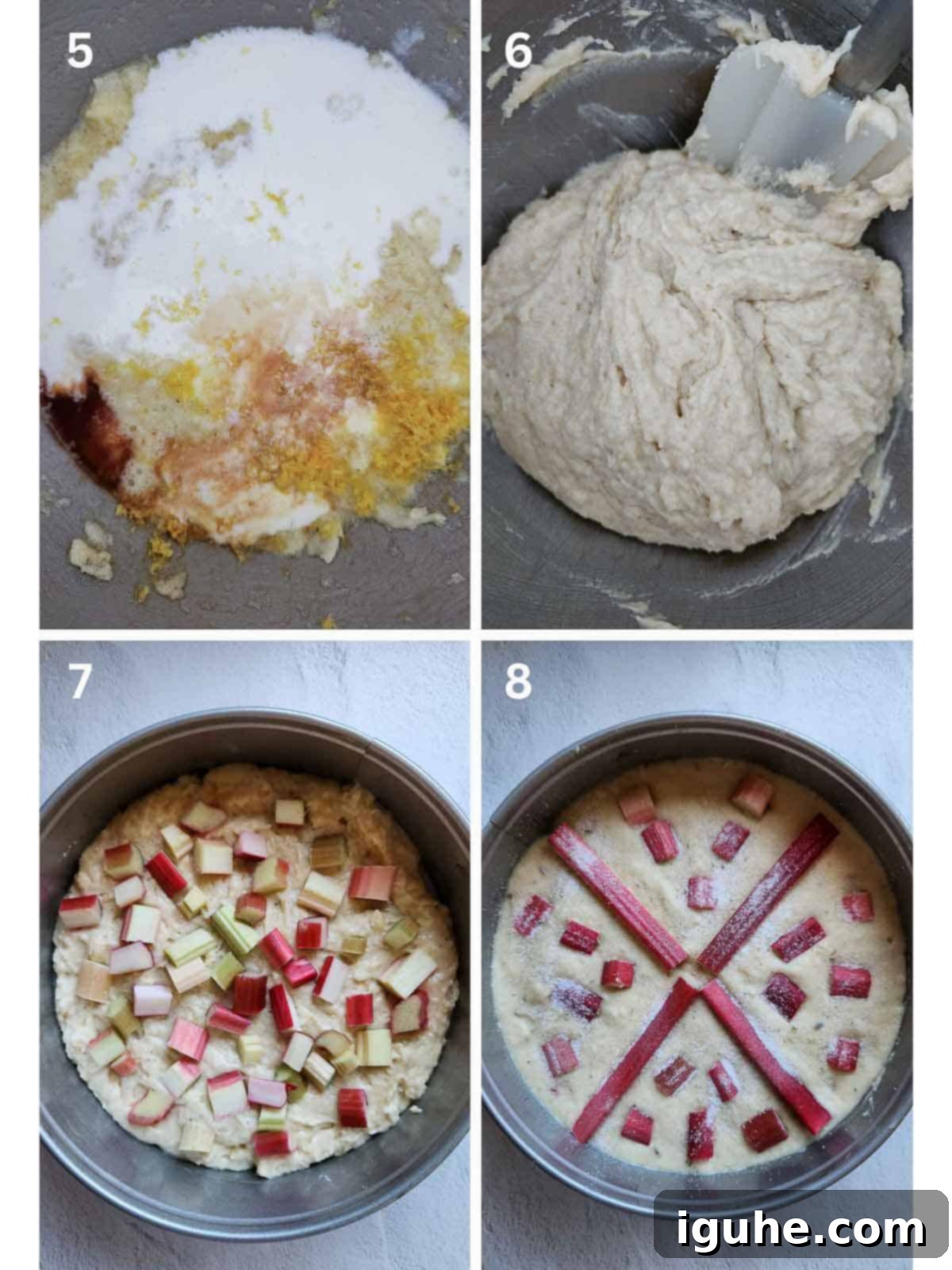
5. Mix in Liquids: After the eggs are incorporated, add the vanilla extract, room-temperature buttermilk, and fresh lemon zest to the batter. Mix on low speed until just combined. The mixture might look slightly curdled, which is normal with cold ingredients; this is why room temperature is ideal.
6. Incorporate Dry Ingredients: In a separate large bowl, whisk together the all-purpose flour, almond flour, baking powder, baking soda, salt, and ground ginger. Gradually add this dry mixture to the wet ingredients in batches, mixing on low speed *just* until the flour is incorporated and no streaks remain. Be careful not to overmix, as this can lead to a tough cake.
7. Layer Batter and Rhubarb: Pour approximately half of the cake batter into your prepared 9-inch springform pan. Evenly scatter half of the chopped rhubarb pieces over the batter. This first layer of rhubarb ensures the fruit is distributed throughout the cake, not just on top.
8. Finish Layering and Bake: Gently spoon the remaining batter over the rhubarb layer and spread it evenly across the pan. Arrange the rest of the chopped rhubarb on top of the cake. You can get creative here and make a pretty pattern, or simply scatter the rhubarb for a charming, rustic look. Finally, sprinkle the reserved 1 tablespoon of lavender sugar evenly over the top of the batter. This will create a wonderfully fragrant and slightly crunchy crust. Bake in a preheated 350°F (175°C) oven for 45-55 minutes, or until the cake is golden brown and a wooden skewer or toothpick inserted into the center comes out clean. Allow the cake to cool in the pan for 10 minutes before releasing the sides of the springform pan. Serve warm or at room temperature.
👩🍳Expert Baking Tip
For perfect results every time, ensure your butter, buttermilk, and eggs are at room temperature before adding them to the batter. This allows all ingredients to emulsify properly, creating a smooth, cohesive batter that traps air effectively, resulting in a lighter, more evenly textured cake. Cold ingredients can lead to a lumpy batter and a dense final product.
Creative Flavor Pairings: Mix It Up!
Rhubarb is incredibly versatile and pairs surprisingly well with a diverse range of flavors and spices. Don’t hesitate to experiment with these delightful combinations to customize your cake:
- Orange Zest: While lemon offers a bright tang, swapping out the lemon zest for orange zest introduces a sweeter, warmer citrus note that harmonizes beautifully with rhubarb. The slight bitterness from the orange peel also adds a sophisticated depth.
- Warm Spices (Cardamom or Cinnamon): Elevate the aromatic complexity by playing with spices. A delicate hint of ground cardamom complements the floral lavender and tart rhubarb wonderfully, lending an exotic touch. Alternatively, a classic dash of cinnamon brings comforting warmth, making the cake feel even more inviting and familiar.
- Add Other Fruits (Strawberries, Peaches, or Plums): Rhubarb is an excellent partner for other seasonal fruits. Consider adding sliced strawberries for a classic sweet-tart combination, or incorporating diced peaches or plums for a juicy, summery twist. Ensure all fruits are cut into similar-sized pieces (around ¾-inch) to guarantee even baking and prevent some pieces from becoming overly soft while others remain firm.
- Almond Extract: For a richer, nutty undertone that enhances the almond flour already in the recipe, try substituting half of the vanilla extract with almond extract. This provides a sophisticated and deep flavor dimension that complements the floral and fruity notes.
- Crunchy Toppings (Pistachios or Almonds): Introduce a delightful textural contrast by sprinkling crushed pistachios (their vibrant green also adds visual appeal!) or toasted almonds over the top of the batter before baking. This creates a satisfying crunch that beautifully complements the cake’s soft crumb.
- Rose Water or Orange Blossom Water: For adventurous bakers who love experimenting with unique and delicate floral notes, a small splash (start with about ½ teaspoon) of pure rose water or orange blossom water added along with the vanilla can impart an ethereal, perfumed quality. These essences further enhance the cake’s aromatic complexity; remember to use them sparingly as they can be quite potent.
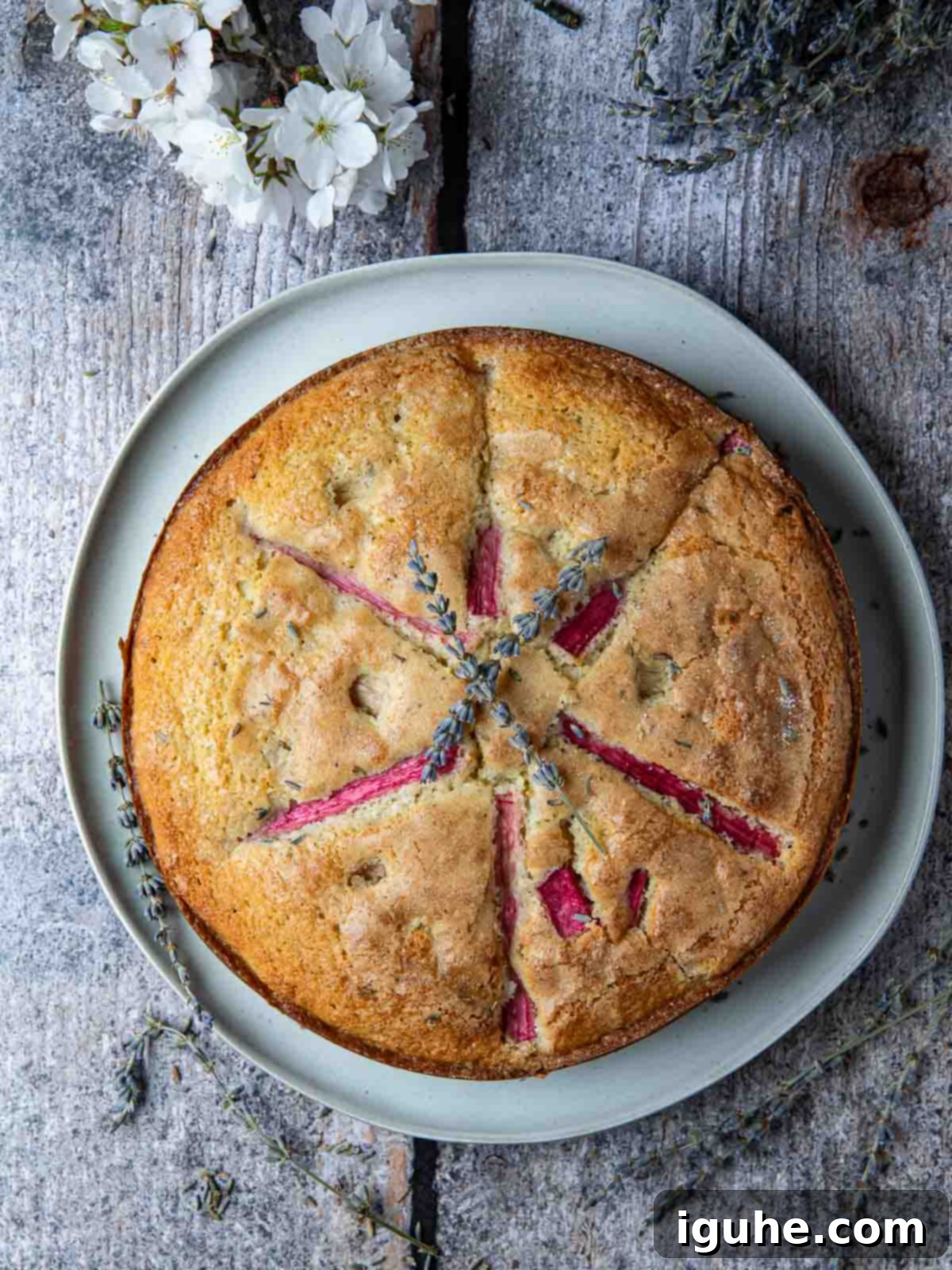
Serving Suggestions for an Enhanced Experience
This fragrant rhubarb and lavender cake is truly outstanding on its own, needing no embellishment. However, for those looking to elevate the experience, here are a few perfect pairings that will make this dessert even more special:
- Vanilla Ice Cream: Is there a more iconic duo than cake and ice cream? A scoop of creamy vanilla bean ice cream or a unique pistachio ice cream alongside a warm slice of this cake creates a delightful contrast in temperature and texture, leading to a truly indulgent dessert experience.
- Fresh Whipped Cream: For a lighter, yet equally luxurious accompaniment, a generous dollop (or two!) of freshly whipped cream provides a cloud-like texture and a delicate sweetness that balances the rhubarb’s tartness beautifully.
- Sweet Fruit Jam: Enhance the cake’s fruity notes by adding a touch of homemade sweet fruit jam, such as strawberry-rhubarb or raspberry, directly on top of your cake slice. This adds an extra layer of fruitiness and sweetness.
- Aromatic Tea: This wonderfully aromatic cake is a perfect companion for a comforting beverage. Enjoy it with a calming cup of freshly brewed lavender tea, a classic black tea, or even a fragrant herbal infusion. The complementary aromas create a truly sensory and relaxing experience.
- Simple Powdered Sugar: For a quick and elegant finish, a dusting of powdered sugar over the cooled cake adds a delicate sweetness and a beautiful presentation, highlighting the cake’s rustic charm.
- Custard Sauce: For a more decadent dessert, consider drizzling a warm vanilla custard sauce over a slice. This adds an extra layer of richness and comfort, especially appealing for a post-dinner treat.
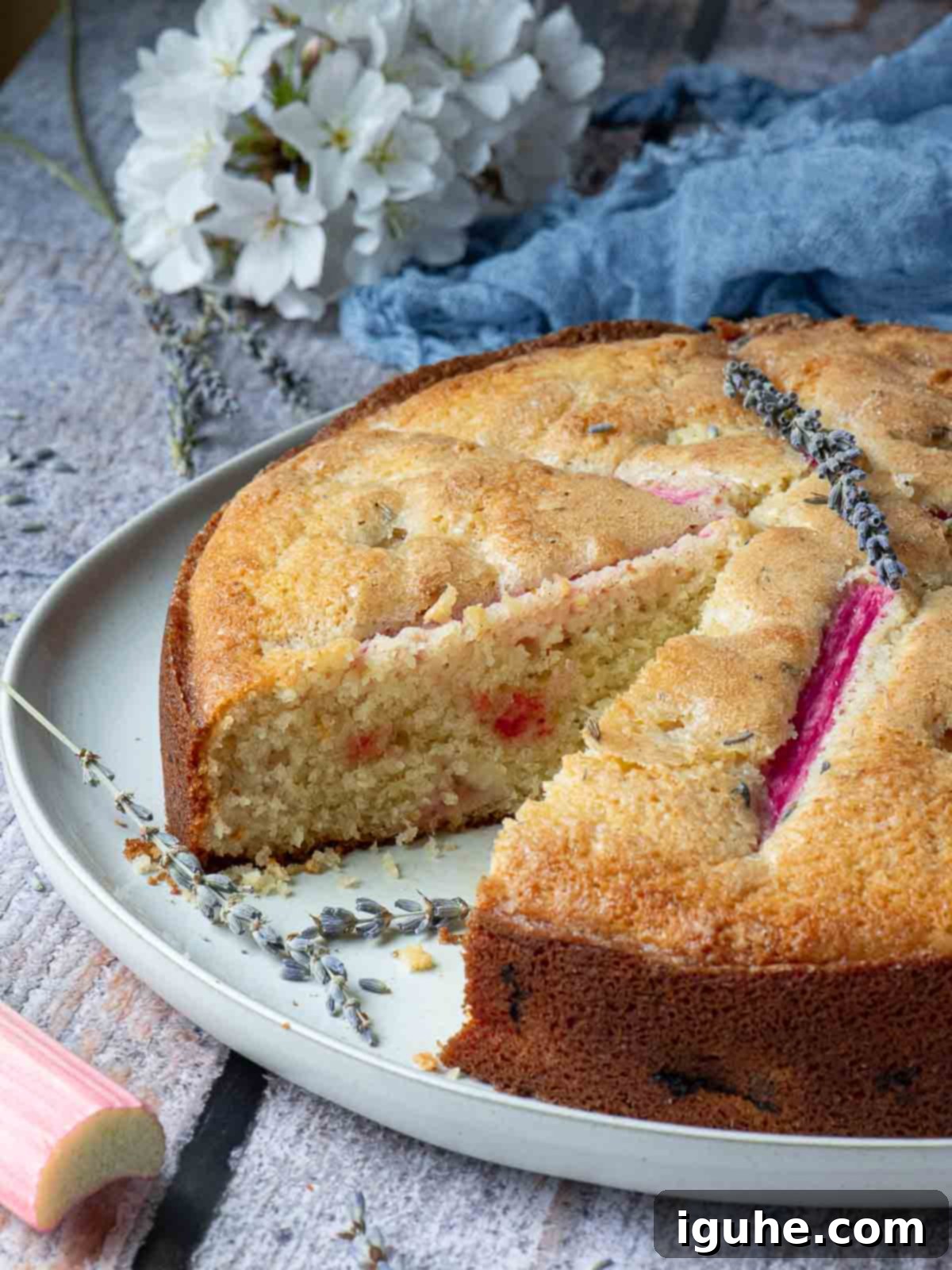
Storage Guidelines for Freshness
To keep your Rhubarb and Lavender Cake tasting its best, proper storage is key. You can store the cake, loosely covered with plastic wrap or in an airtight container, at room temperature for up to 2-3 days. For extended freshness, particularly in warmer climates, or if you prefer your cake chilled, it can be kept covered in an airtight container in the refrigerator for up to 5 days. While the lovely crunchy sugar topping may soften over time due to moisture absorption, the cake itself will retain its wonderful flavor and moist texture.
This cake also freezes beautifully! Once completely cooled, wrap individual slices or the entire cake tightly in plastic wrap, then an additional layer of aluminum foil. It can be stored in the freezer for up to 2-3 months. To enjoy, thaw overnight in the refrigerator, then bring to room temperature before serving for the best flavor and texture.
Frequently Asked Questions About Rhubarb & Lavender Cake
Rhubarb has a distinctly tart, tangy, and slightly sour flavor, often compared to a green apple or lemon. Its sharp acidity means it’s almost always paired with sugar or other sweet elements when cooked. While raw rhubarb is crunchy and quite sour, cooking it transforms its texture, making it soft and mellowing its flavor into a pleasant, fruity tartness that works wonderfully in both sweet and savory dishes.
When selecting rhubarb, look for stalks that are firm, crisp, and free from any significant blemishes or limpness. The color can vary significantly by variety, from vibrant crimson red to rosy pink, or even pale green, so don’t assume green stalks are unripe—they can be just as flavorful! Most rhubarb sold in markets will have the toxic leaves already removed; if not, be sure to discard them before use. You’ll typically find fresh rhubarb in season during late spring and early summer at local grocery stores, farmers’ markets, and specialty produce shops.
Generally, there’s no need to peel rhubarb for baking. Its skin is thin and softens beautifully during cooking, contributing both color and a subtle texture to your dish. However, if you encounter exceptionally thick, fibrous, or particularly tough stalks, you may choose to lightly peel the outer layer. This can be done by gently pulling off any noticeable strings with a knife or vegetable peeler, similar to how you might destring celery. For this Rhubarb and Lavender Cake, simply washing and chopping is usually sufficient.
No, it is highly recommended to use dried culinary lavender buds for baking, not fresh. Fresh lavender can be very potent and may impart a much stronger, sometimes overpowering, flavor that doesn’t distribute evenly. Dried culinary lavender, specifically processed for consumption, offers the perfect balance of fragrance and taste for delicate recipes like this cake. Ensure your dried lavender is stored in an airtight container in a cool, dark place to maintain its potency and aroma.
Explore More Delightful Spring Recipes
Discover other seasonal recipes that are sure to bring a smile to your face and freshness to your table.
- Coconut Lime Macaroons
- Labneh Toast with Roasted Strawberries
- Savory Lemon Thyme Popovers
- Blackberry Boursin Grilled Cheese
Did you make this recipe? We would love to hear about it! Please leave a ⭐⭐⭐⭐⭐ rating with a comment right below the recipe card. If you snap a photo of your creation, don’t forget to tag us on Instagram @brunchandbatter.
📖Recipe
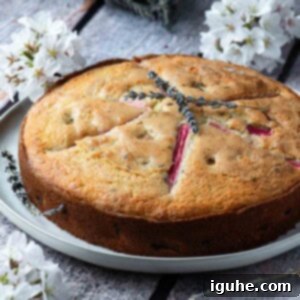
Rhubarb and Lavender Cake
Pin Recipe
Equipment
-
food processor, grinder, or mortar and pestle
-
stand mixer or handheld mixer
-
9-inch springform pan or equivalent
Ingredients
Lavender Sugar
- ½ cup (plus 1 tbsp) white granulated sugar
- 1¼ teaspoon lavender buds look for culinary or food grade
For the Cake
- 1½ cups all-purpose flour
- ½ cup almond flour
- 1 teaspoon baking powder
- ½ tsp baking soda
- ¼ teaspoon Kosher or fine sea salt
- ½ teaspoon ground ginger
- ½ cup lavender sugar, plus 1 tbsp, divided see above
- ½ cup white granulated sugar
- ½ cup (1 stick or 4 ounces) unsalted butter, room temperature
- 2 large eggs, room temperature
- 1 teaspoon vanilla extract
- 1 cup buttermilk, room temperature
- 1 tablespoon lemon zest (from about 1 medium-sized lemon)
- 1½ cups chopped rhubarb, (¾-inch pieces) from about 2 large rhubarb stalks
Instructions
For the Lavender Sugar
-
Add ½ cup white granulated sugar and 1¼ teaspoon lavender buds to the bowl of a food processor (or use a spice grinder, or mortar and pestle). Pulse until the lavender is broken up into fine pieces, and the sugar is fragrant. Set aside.1¼ teaspoon lavender buds, ½ cup white granulated sugar
For the Cake
-
Preheat your oven to 350℉ (175°C). Prepare a 9-inch springform pan (or an equivalent size round baking pan) by spraying it generously with baking spray, or by buttering and flouring it thoroughly.
-
In a large bowl, whisk together the all-purpose flour, almond flour, baking powder, baking soda, Kosher or fine sea salt, and ground ginger until well combined. Set this dry mixture aside.1½ cups all-purpose flour, ½ cup almond flour, 1 teaspoon baking powder, ½ teaspoon baking soda, ¼ teaspoon Kosher or fine sea salt, ½ teaspoon ground ginger
-
In the bowl of a stand mixer fitted with the paddle attachment (or using a hand mixer), cream together the ½ cup white granulated sugar, ½ cup lavender sugar (reserving 1 tablespoon of the lavender sugar for later), and ½ cup unsalted butter (room temperature) on medium speed. Beat for about 3 minutes until the mixture is light, fluffy, and creamy.½ cup (plus 1 tbsp) white granulated sugar, ½ cup lavender sugar, plus 1 tbsp, divided, ½ cup (1 stick or 4 ounces) unsalted butter, room temperature
-
With the mixer still on medium speed, add the 2 large eggs (room temperature) one at a time, mixing well after each addition until fully incorporated. Then, add the 1 teaspoon vanilla extract, 1 cup buttermilk (room temperature), and 1 tablespoon lemon zest. Mix until just combined. Turn the mixer down to low speed, then gradually add the dry flour mixture in batches. Mix just until the flour is incorporated and no dry streaks remain. Be careful not to overmix the batter.2 large eggs, room temperature, 1 teaspoon vanilla extract, 1 cup buttermilk, room temperature, 1 tablespoon lemon zest (from about 1 medium-sized lemon)
-
Pour half of the batter into the prepared pan. Evenly scatter half of the 1½ cups chopped rhubarb on top of the batter. Carefully spoon the remaining batter over the rhubarb and spread it gently until it’s even in the pan. Add the rest of the chopped rhubarb to the top of the cake, gently pressing the pieces into the batter. Feel free to create a decorative pattern or simply scatter them for a rustic look. Lastly, sprinkle the reserved 1 tablespoon of lavender sugar evenly over the entire top of the batter. Bake for 45-55 minutes, or until the cake is golden brown and a wooden skewer or toothpick inserted into the center comes out clean. Let the cake cool for 10 minutes in the pan before removing the sides (if using a springform pan). Serve warm or at room temperature.
Notes
- Always use food-grade or culinary lavender for baking to ensure the best flavor.
- Make sure your butter, buttermilk, and eggs are at room temperature for optimal batter consistency and cake texture.
- There is no need to peel the rhubarb before baking, as its skin softens nicely and adds color.
- Store the cake at room temperature for up to 3 days, or in the fridge for up to 5 days. It also freezes well for up to 2-3 months.
Nutrition*
*Nutrition information is provided as a courtesy and is an estimate only. Nutrition information can vary depending on many factors, such as products used, measurements and substitutions, therefore it is recommended that you obtain nutritional calculations based on your own finished recipe.
